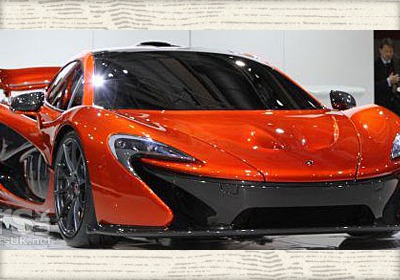McLaren P1: Paris 2012
Thu, 27 Sep 2012The McLaren P1 – spiritual successor to the iconic McLaren F1 – has been publicly revealed at the 2012 Paris Motor Show.
Still, we do have more details on the P1 concept that McLaren say will turn in to a production car in 2013 before it finds its way in to the garages of wealthy McLaren customers in 2014.
The McLaren P1 is designed to be “…the best driver’s car in the world on road and track” according to McLaren, which is setting the bar a bit higher than high, and the concept P1 at Paris is – at least in terms of what we can see – 95 per cent of what the production model will be.
What we have learnt is that the P1 will come with power of 600bhp per tonne which, assuming the P1 is a bit lighter than the MP4-12C – should see up to the 800bhp already suggested from the 3.8 litre V8. And that’s before you add in the extra power supplied by a hybrid KERS of up to another 200bhp. But McLaren still won’t confirm power outputs or performance.
With the P1 designed to handle rather than have outright top speed, downforce is a big deal and McLaren are claiming the P1 has 600kg of downforce at less than maximum speed, as much as the 12C GT3 and many times that of the MP4-12C.
The P1 uses a core carbon fibre structure for the tub – the MonoCage – which has a roll-bar section which is visible on the roof and incorporates the trademark scoop of the F1 to direct clean air in to the engine bay. More cooling is supplied by the big air intakes in the doors, ‘clutch’ scoops on the back wings and three radiators in the nose of the P1.
The big back wing works with two flaps under the front of the P1 which operate through a 60 degree angle to control downforce, with the the big back wing automatically adjusting to boost downforce and optimise aerodynamics. It can extend rearwards by up to 300mm on track and 120mm on the road and both work together to boost handling, braking and downforce and the rear wing can also act as an airbrake.
Simon Lacey, the man at McLaren in charge of aero performance, said:
The astonishing downforce actually makes driving easier as well as faster. As you go faster, you actually feel more in control.
Every body panel, air intake, and air exhaust was designed to guide in air from the most efficient places and to maximise cooling,’ says Lacey. ‘That’s partly why the body is so compact, and looks so “shrink wrapped”. The unusual door ducts, from the initial styling sketches, draw air into the cooling circuit. That low body helps air get to the rear wing. The rear deck is extraordinarily low, just like a sports racing car. The extreme teardrop shape of the glasshouse guides more air more efficiently to the rear wing.’
The P1 is built from very few body panels. There’s a big clamshell single-moulded front and rear panel which get stuck to the MonoCage plus the doors, bonnet, boot and two access panels to complete the P1′s body. The panels are very thin and light and incorporate scoops and ducts to boost aero performance.
McLaren’s Design Director, Frank Stephenson, said:
I wanted it to be striking but also functional, a real statement of intent. I wanted a genuinely beautiful and dramatically honest “supersports” car, in keeping with McLaren’s heritage but also at the forefront of automotive design.
I wanted it to look like a Le Mans racer with that low body, long rear deck and open mesh rear styling to put the mechanicals on view and to help cooling,’ says Stephenson. ‘Plus there is the most aggressive rear diffuser ever seen on a road car. Like everything on the McLaren P1, it’s there for a good reason.
It seems we won’t get official prices or powertrain and performance details until spring 2013 (and the P1 will only come in left hand drive – so definitely no F1 three seats going on). But the McLaren P1 is stacking up to be very special indeed.
McLaren P1 Photos >>
By Cars UK

